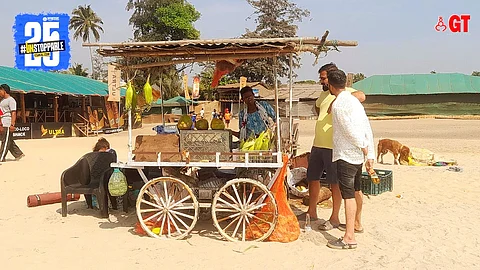

Michael Lobo, MLA and member of the ruling dispensation has been quoted by a section of the media as saying: “The sale of idli-sambar in beach shacks is causing a ‘decline’ in international tourist footfalls in Goa.”
The quote has left many domestic and foreign tourists in South Goa amused because they believe that the government is reaping what it has sown.
“We moved from Delhi to North Goa because then, it was a heaven for us. The place was full of greenery and quaint little houses. The traffic was manageable and the neighbourhood welcoming,” reminiscences Rita.
“Within a few years of our moving, we saw hills disappearing and small houses give way to huge apartments, and water started becoming scarce. Loud music could be heard till morning, and Goa had slowly started losing its charm in the north,” she adds, explaining shifting again, from the north to the south last year.
That shift, from the north to the south, is also evident among tourists, and South Goa is beginning to understand the vibe of what it means to welcome guests.
“In the early 1980s, we used to see (domestic) tourists gaping at us when dawn broke as we danced during beach parties,” recollects foreign tourist Nirmala, for whom Anjuna is now a dream.
“I loved eating toasted sliced bread with butter and sugar or honey after the swim, but I will not be surprised if the menus in North Goa have changed to suit their present clients.
An Indian would love to have the breakfast he has grown up having as would a foreigner. If they didn’t serve idlis, then, it was because there were no domestic tourists back then,” reasons Nirmala.
“I remember trying my first idli at a restaurant in Mapusa when I used to go to the Friday market. I sort of liked it because I found it light, though the masalas that came with it were spicy,” remembers the lady who has been visiting Goa for the last 12 years.
Shacks at Arambol in North Goa, apart from mostly being run by Indians, are frequented by families from India, and it is no surprise that they order Indian food.
“Idlis, sambars and other vegetarian dishes are normal choices,” says Atul, as he waits on his clients.
Shacks at Arambol in North Goa, apart from mostly being run by Indians, are frequented by families from India, and it is no surprise that they order Indian food.
From among the 12 shacks that dot Arambol Beach, nine serve food that suits the Indian palate.
“We have to serve what the guests want. There is hardly any demand for fish-curry-rice or continental food. Sometimes, they do ask for fish thali,” confesses Atul.
If idli sambar is in demand in the north, sea food is the choice in the south with vegetables sauteed in olive oil. A lot of wine is drunk, unlike beer, which is more sought-after in the north.
“Instead of saying that foreign tourists are not coming because of noise, and nature being polluted, your minister is trying to blame it on the food served,” rues travel agent, Rui.
“Goa has sold itself to Indian tourists, and therefore, must cater to their needs and not complain about it,” thinks Nino from the UK. “Worse still,” she says, “the crowd that is coming now is brash, and it makes many of us uncomfortable.”
A lot of people from other States have decided to make their second home in South Goa, and practically all of them hope that the nuances of the north will not follow them to the south.
“There is still the old Goan charm alive out here. Goa will never be the same without a Goan, and the more they leave the place, the more frightful it is for us,” says Monica after taking an evening stroll.
For a Goan, or anyone who has chosen to live in Goa, the problem is not what is served, but how service is accepted. Because, living in Goa is about being good.